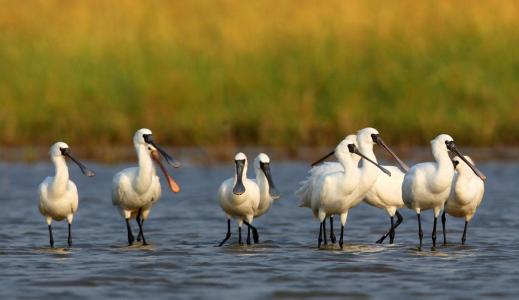What level of animal is the black-faced spoonbill? What does the black-faced spoonbill look like? is the black-faced spoonbill a migratory bird
What does a black-faced spoonbill look like? As soon as you hear the name, you will feel whether it looks similar to the pipa, yes, because the long flat spoon-shaped mouth is very similar to the pipa in Chinese musical instruments, hence the name. Are black-faced spoonbills migratory birds? Yes, it has to migrate, too. It is also a second-class protected animal of wild animals.

When the black-faced spoonbill returned to the north, the research team of the Special Health Center and the Department of Life Sciences of normal University left behind the world's leading sketch of the genome of the black-faced spoonbill to unravel the secrets of the black-faced spoonbill for tens of thousands of years. About two-thirds of the world's more than 4,000 black-faced spoonbills spend the winter in Taiwan. An important contribution to allowing researchers to unravel the genome sketch of 1.19 billion base pairs is the black-faced spoonbill samples obtained from botulinum poisoning in 2002 and the high-quality DNA samples obtained from rescuing injured black-faced spoonbills in Tainan in 2015.
Yao Zhengde, an associate researcher at the Special Health Center, said that through the sketch of the genome of the black-faced spoonbill, we can see that the population began to decline after the ice age 18,000 years ago, but the number is still estimated to reach more than 60,000. However, with the changes in human life, such as war and the use of pesticides, the global population of black-faced spoonbills dropped to less than 300 in the 1990s, once allowing black-faced spoonbills to be inbred only. Later, through the continuous promotion of habitat conservation in various countries, the population rebounded to more than 4,000 within 30 years. The bottleneck effect caused by the decline in population has also made the research team worry about whether the genetic diversity of black-faced spoonbills will decline, affecting the environmental adaptability of the population in the long run.
The bottleneck effect has little effect on the continued increase in population diversity of black-faced spoonbills. "We have analyzed that ethnic and ethnic diversity is in a state of synchronization, and ethnic diversity has recovered and ethnic diversity has gradually caught up. The negative effects of inbreeding have also gradually alleviated, which is a doubly optimistic situation. Yao Zhengde believes that although the genome map is quite optimistic, in fact, it still depends on habitat conservation to enable the population and genetic diversity of black-faced spoonbills to continue to grow.
Black-faced spoonbill habitat scattered wetlands conservation to keep up. At present, there are still some differences between the black-faced spoonbill conservation wetlands listed in Taiwan and the actual black-faced spoonbill gathering hotspots. The largest number is about 469 in Tainan Tucheng wetland, followed by 389 Chiayi cloth bags. Black-faced spoonbills also began to gather in some substratum because the water did not recede. According to a survey conducted by the Wild Bird Society of the Republic of China and the National Bird Society in 2018, it is also shown that black-faced spoonbills are widely distributed in Taiwan, which can reduce the risk of survival, but habitat conservation work also needs to be synchronized so that black-faced spoonbills can continue to come to Taiwan for the winter.
- Prev

Coffee grounds grow mushrooms: coffee grounds raise mushrooms? Can mushroom feet be planted in coffee grounds?
Do you know how to grow mushrooms with coffee grounds? Let's learn about it. First of all, you need to prepare the bacteria you want to plant, and then find the coffee grounds you need. Let's take a look at how to grow them. 1. You need to put the bag or container to 2 full, and coffee.
- Next

What level of animal is the black-faced spoonbill? Black-faced spoonbill habitat Zhuanghe, migration route of black-faced spoonbill
Do you know a bird like the black-faced spoonbill? Its number is very small. What level of animal is the black-faced spoonbill? It is a second class protected wild animal. So we should take good care of it. Zhuanghe Shicheng Island-shaped Mantuo and Wangjia Town Yuanbaotuo are black-faced spoonbills in China.
Related
- Fuxing push coffee new agricultural production and marketing class: lack of small-scale processing plants
- Jujube rice field leisure farm deep ploughing Yilan for five years to create a space for organic food and play
- Nongyu Farm-A trial of organic papaya for brave women with advanced technology
- Four points for attention in the prevention and control of diseases and insect pests of edible fungi
- How to add nutrient solution to Edible Fungi
- Is there any good way to control edible fungus mites?
- Open Inoculation Technology of Edible Fungi
- Is there any clever way to use fertilizer for edible fungus in winter?
- What agents are used to kill the pathogens of edible fungi in the mushroom shed?
- Rapid drying of Edible Fungi

